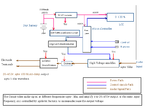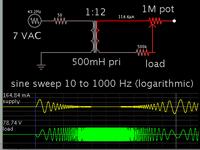Gaber2611
Member level 1
Hello everybody,
i am working on electronic circuit design, which takes audio input up to 1khz waveform, "the audio wave forms are different and at different frequencies", its maximum frequency is 1khz
and required to output the same frequency at voltage from 20-450v , at very low ampere " Doesn't exceed 100 Micro-ampere"
also the output voltage needs to be controlled, up/down buttons, to increase and decrease the output voltage, and displayed with 0-100 counter on LCD screen
any suggestion for simple design to follow for this circuit?,
im thinking of using micro-controller, for controlling the voltage and the LCD display, but i hope to avoid using the micro-controller, cause im not familiar with the programming, and for the high voltage output im using transformer, so any suggestion?, how you would design this circuit?, which block diagram you would follow?
Note: the circuit will be powered by 2AA batteries of 3dcv, 2100MAH
will appreciate your replies a lot,
Thanks in advance
i am working on electronic circuit design, which takes audio input up to 1khz waveform, "the audio wave forms are different and at different frequencies", its maximum frequency is 1khz
and required to output the same frequency at voltage from 20-450v , at very low ampere " Doesn't exceed 100 Micro-ampere"
also the output voltage needs to be controlled, up/down buttons, to increase and decrease the output voltage, and displayed with 0-100 counter on LCD screen
any suggestion for simple design to follow for this circuit?,
im thinking of using micro-controller, for controlling the voltage and the LCD display, but i hope to avoid using the micro-controller, cause im not familiar with the programming, and for the high voltage output im using transformer, so any suggestion?, how you would design this circuit?, which block diagram you would follow?
Note: the circuit will be powered by 2AA batteries of 3dcv, 2100MAH
will appreciate your replies a lot,
Thanks in advance


